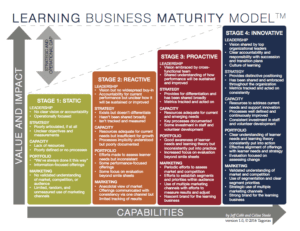With the constant flood of new content pouring through the Internet pipes these days, being aware of all of it and sorting it out in meaningful ways as in individual simply isn’t possible.
This is why the process of curation is a concept all of us—particularly those of us in the learning business—definitely need to embrace.
In this episode of the Leading Learning podcast, Celisa and Jeff discuss the topic of curation including what it is, why they think it is an important concept for the learning business, and ideas around how to be an effective curator.
To tune in, just click below. To make sure you catch all of the future episodes, be sure to subscribe by RSS or on iTunes. And, if you like the podcast, be sure to give it a tweet!
Listen to the Show
Read the Show Notes
[00:18] – A preview of what will be covered in this podcast where Celisa and Jeff discuss the concept of curation.
[00:37] – Thank you to Castle, which is the sponsor of the Leading Learning podcast for the second quarter of 2017. Castle is an accomplished, full-services certification and licensure testing company that also offers its clients a variety of learning solutions capabilities. With an expert team of testing and instructional design professionals, and a 30-year history of excellence in its field, Castle understands what it takes to develop and deliver quality learning and certification programs. To find out more about Castle’s custom learning solutions, go to https://www.leadinglearning.com/castle.
[01:14] – Highlighted Resource of the Week –Leading Learning newsletter – a way to share high-value resources we come across each month, packaged up into a brief email that you can read and digest quickly. If the podcast is “audio intelligence for learning leaders”, the newsletter is “inbox intelligence for learning leaders”. Get the details and sign up for this free resource at https://www.leadinglearning.com/newsletter/.
What is a curator?
[01:53] – According to Merriam-Webster, a curator is:
One who has the care and superintendence of something.
So curators are the people and organizations that do the hard work of sifting through the content in a particular topic area and pulling out the things that seem to make most sense and be most relevant for the curators’ audience.
This curation effort involves significantly more than finding and regurgitating links, though.
The best curators are skilled at:
- Locating and evaluating valuable content
- Organizing and connecting content so that it is as accessible as possible
- Creating and re-purposing content when it adds to the underlying value
- Capitalizing on social media to build connections and context
- Building trusted relationships with learners and other curators
- Designing learning experiences (in a much broader sense than traditional approaches)
Bottom line: A curator is an individual who or an organization that excels at helping others make sense and – this part is important – this person or organization is strategic in pursuing curation.
You can’t really help a whole lot with “sense-making” if you aren’t strategic – you would just be adding to the noise.
The ways to go about curation are as varied as there are tools, organizations, and individuals who are going to do it.
In some cases it’s going to be core to the business model of an organization. For example, AbleThrive who describe themselves as “a one-stop platform for people with disabilities and their families to access curated and customized resources from around the world.”
There are also individuals and organizations who make it a smaller part of the services they offer.
An example of this is David Kelly.
Also note, this type of curation is what we do with our monthly Leading Learning newsletter.
So curation can come in the form of newsletters, websites, or even podcasts—such as Marketing Over Coffee.
The Opportunities
[08:01] – For learning business professionals, curation represents a number of opportunities:
1. Use curation to help give you an edge in your own professional or personal learning. This may mean a focus on developing your own knowledge in skills. For example, the domain areas of the Learning Business Maturity Model.

It may also mean building knowledge and skills and finding new areas of need in the field or industry your organization serves.
2. Use curation as a way to stay on top of key issues and trends in the field or industry you serve. This can be especially helpful if, as is often the case, the education staff does not have significant subject matter expertise itself in the areas for which it is in charge of providing learning opportunities.
3. You can become a curator not just for yourself, but for the audience you serve. learning businesses can create significant value through being curators. Curation is how we come up with our monthly newsletter. Keep in mind too that curation can be an ongoing effort, or it can be focused around a specific event, like an annual meeting.
Sources, Tools, and Process
[12:11] – Sources
- Pay attention to who provides the most interesting content for any newsletters or other content sources you access regularly. Does this person or organization have a blog? Subscribe to it. A Twitter handle? Follow them.
- Same as above with speakers at conferences you attend or books you read.
- Or simply search on Google and Twitter on topics you care about the most. If you see blogs, videos, Tweets, etc., that capture your interest, subscribe/follow.
[13:50] – Tools:
- Feedly for subscribing to blogs or anything else that has an RSS feed—and be sure to check out our brief video about this.
- Hootsuite as a great tool for managing Twitter and other social media channels. You can create lists of key people or hashtags you track.
- Instapaper as a tool to save, read, and manage all the things you find on the Internet.
- Scoop.it and Paper.li – platforms that allow you to find content and publish it out as a web-based paper for people to read.
[16:45] – Process
When you first start out, you may find that you end up subscribing to or following a lot of stuff and that’s okay. You can always pare down and refine over time until you get to the set of curated content that is most consistently valuable to you.
To “unsubscribe” and “unfollow” are an important part of the process and just as you should do this, you’ll likely also be adding new subscriptions and follows as new topics come under your curation umbrella and as your—and your audience’s—understanding of a topic shifts and matures and therefore needs new content to feed it appropriately.
One additional word of advice in finding sources:
Don’t just pick curators who seem to always be towing the same old line and writing about things you already know and believe in. Find ones that are willing to mix it up some and take some risks.
Rohit Bhargava (who keynoted at our Leading Learning Symposium a couple years ago) does something similar with his annual trends report, but he accumulates for a year before sifting. And he is fan of collecting physical clippings and putting them in folders—see our related podcast episodes with Rohit, Curiosity and Curation with Rohit Bhargava and Non-Obvious Learning with Rohit Bhargava.
[19:57] – Basically, there is no “right” process for curation. It takes time to figure how you are best able to find and extract value. If it were as easy as just sending out any interesting link you found, then there would not be a lot of value in curation.
We would love to hear from listeners to find out what you’re doing with curation.
For example, do you have a process and/or do you have particular tools you like to use?
Please share at the bottom of this page in the “Comments” section (and, as always, feel free to leave comments/questions in the comments section on the page for any other episodes of the podcast).
[21:25] – Wrap Up
Thanks again to Castle, a full service certification and licensure testing company that also offers its clients a variety of learning solutions capabilities, for sponsoring this episode of the Leading Learning podcast.
If you are getting value from the Leading Learning podcast, be sure to subscribe by RSS or on iTunes. We’d also appreciate if you give us a rating on iTunes by going to https://www.leadinglearning.com/apple.
Also, please tell others about the podcast. Go to https://www.leadinglearning.com/share to share information about the podcast via Twitter, or send out a message on another channel of your choosing with a link to https://www.leadinglearning.com/podcast.
[23:20] – Sign off
See Also:


 Thinking Like a Course Entrepreneur with Thinkific’s Greg Smith
Thinking Like a Course Entrepreneur with Thinkific’s Greg Smith
Leave a Reply